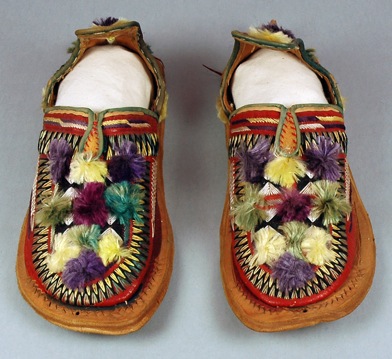Bridal slippers
Berber people, Agadir, Morocco
 Collected and donated by A.E. or E.A. Alport in 1961; 1961.10.2These slippers are made from natural leather soles with red leather uppers and are profusely embroidered with yellow, green, purple and plum coloured silks. They formed part of the trousseau given by a father to his daughter on the occasion of her first marriage and may have been worn at the three-day wedding celebration during which the bride makes several outfit changes.
Collected and donated by A.E. or E.A. Alport in 1961; 1961.10.2These slippers are made from natural leather soles with red leather uppers and are profusely embroidered with yellow, green, purple and plum coloured silks. They formed part of the trousseau given by a father to his daughter on the occasion of her first marriage and may have been worn at the three-day wedding celebration during which the bride makes several outfit changes.
The trousseau, which may contain other items of clothing, jewellery, ornaments, gold, and luxury fabrics, remains the daughter's property even once married. If she divorces, it has to be returned by her husband (although he will retain rights over any children). A woman's trousseau is important because is shows the family's status and their conformation to community cohesion. The size and value of a woman's assets provides her with a better bargaining position.
In addition to the trousseau, according to custom, the groom should provide a dowry. This includes a gold belt and items in groups of threes: three kaftans, three perfumes, and so on. An old joke is that a man prefers a slim bride as less gold is required to make the belt. Traditionally, a man may have more than one wife but he must obtain his first wife's permission in writing before marrying again. Berber marriages were also endogamous; that is, arranged between two members of the same tribe or lineage group. Today, especially in urbanised areas of Morocco, both polygamous and arranged marriages are on the decrease as young people embrace more liberal and 'modern' attitudes to marriage.
